Mahatma Gandhi
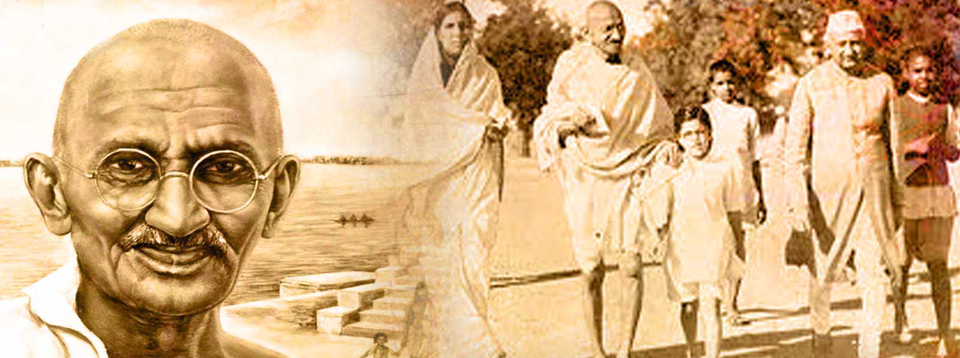
Mahatma Gandhi First Television Interview
This is Mahatma Gandhi’s first television interview. On 30 April 1931 Gandhi gave this interview to Fox Movietone News and also met the peasants of Bardoli. This precious clipping is from the archives of Fox News Movietone.
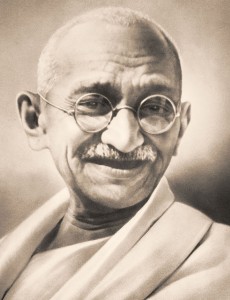 Mohandas Karamchand Gandhi (pronounced [ˈmoːɦənd̪aːs ˈkərəmtʃənd̪ ˈɡaːnd̪ʱi] (
Mohandas Karamchand Gandhi (pronounced [ˈmoːɦənd̪aːs ˈkərəmtʃənd̪ ˈɡaːnd̪ʱi] (![]() listen); 2 October 1869 – 30 January 1948) was the preeminent leader of Indian nationalism in British-ruled India. Employing nonviolent civil disobedience, Gandhi led India to independence and inspired movements for civil rights and freedom across the world. The honorific Mahatma (Sanskrit: “high-souled”, “venerable”)—applied to him first in 1914 in South Africa,—is now used worldwide. He is also called Bapu (Gujarati: endearment for “father,” “papa”) in India.
listen); 2 October 1869 – 30 January 1948) was the preeminent leader of Indian nationalism in British-ruled India. Employing nonviolent civil disobedience, Gandhi led India to independence and inspired movements for civil rights and freedom across the world. The honorific Mahatma (Sanskrit: “high-souled”, “venerable”)—applied to him first in 1914 in South Africa,—is now used worldwide. He is also called Bapu (Gujarati: endearment for “father,” “papa”) in India.
Born and raised in a Hindu, merchant caste, family in coastal Gujarat, western India, and trained in law at the Inner Temple, London, Gandhi first employed nonviolent civil disobedience as an expatriate lawyer in South Africa, in the resident Indian community’s struggle for civil rights. After his return to India in 1915, he set about organising peasants, farmers, and urban labourers to protest against excessive land-tax and discrimination. Assuming leadership of the Indian National Congress in 1921, Gandhi led nationwide campaigns for easing poverty, expanding women’s rights, building religious and ethnic amity, ending untouchability, but above all for achieving Swaraj or self-rule.
Gandhi famously led Indians in challenging the British-imposed salt tax with the 400 km (250 mi) Dandi Salt March in 1930, and later in calling for the British to Quit India in 1942. He was imprisoned for many years, upon many occasions, in both South Africa and India. Gandhi attempted to practise nonviolence and truth in all situations, and advocated that others do the same. He lived modestly in a self-sufficient residential community and wore the traditional Indian dhoti and shawl, woven with yarn hand spun on a charkha. He ate simple vegetarian food, and also undertook long fasts as means of both self-purification and social protest.
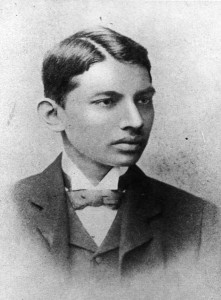 Gandhi’s vision of a free India based on religious pluralism, however, was challenged in the early 1940’s by a new Muslim nationalism which was demanding a separate Muslim homeland carved out of India. Eventually, in August 1947, Britain granted independence, but the British Indian Empire was partitioned into two dominions, a Hindu-majority Indiaand Muslim Pakistan. As many displaced Hindus, Muslims, and Sikhs made their way to their new lands, religious violence broke out, especially in the Punjab and Bengal. Eschewing the official celebration of independence in Delhi, Gandhi visited the affected areas, attempting to provide solace. In the months following, he undertook several fasts unto death to promote religious harmony. The last of these, undertaken on 12 January 1948 at age 78, also had the indirect goal of pressuring India to pay out some cash assets owed to Pakistan. Some Indians thought Gandhi was too accommodating. Among them was Nathuram Godse, a Hindu nationalist, who assassinated Gandhi on 30 January 1948 by firing three bullets into his chest at point-blank range.
Gandhi’s vision of a free India based on religious pluralism, however, was challenged in the early 1940’s by a new Muslim nationalism which was demanding a separate Muslim homeland carved out of India. Eventually, in August 1947, Britain granted independence, but the British Indian Empire was partitioned into two dominions, a Hindu-majority Indiaand Muslim Pakistan. As many displaced Hindus, Muslims, and Sikhs made their way to their new lands, religious violence broke out, especially in the Punjab and Bengal. Eschewing the official celebration of independence in Delhi, Gandhi visited the affected areas, attempting to provide solace. In the months following, he undertook several fasts unto death to promote religious harmony. The last of these, undertaken on 12 January 1948 at age 78, also had the indirect goal of pressuring India to pay out some cash assets owed to Pakistan. Some Indians thought Gandhi was too accommodating. Among them was Nathuram Godse, a Hindu nationalist, who assassinated Gandhi on 30 January 1948 by firing three bullets into his chest at point-blank range.
Gandhi is commonly, though not officially, considered the Father of the Nation in India. His birthday, 2 October, is commemorated there as Gandhi Jayanti, a national holiday, and world-wide as the International Day of Nonviolence.
Early life and background
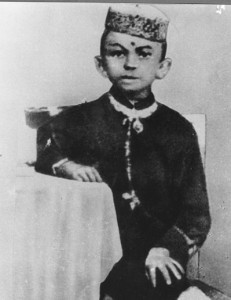 Mohandas Karamchand Gandhi in his earliest known photo, aged 7, c. 1876
Mohandas Karamchand Gandhi in his earliest known photo, aged 7, c. 1876
Gandhi was born Mohandas Karamchand Gandhi, or “Mohan”, on 2 October 1869 to Karamchand Gandhi (called Kaba) and his wife Putlibai in a many-roomed, three-story house in Porbandar which is the present day Kirti Mandir – a temple of peace. Gandhi’s birthplace is in Kathiawar Peninsula (also known as Saurashtra), a region today part of Gujarat state in India, but then within the Bombay Presidency of British India. Described by Gandhi as “a lover of his clan, truthful, brave and generous,” his father was the Diwan (chief minister) of Porbandar at the time of Gandhi’s birth, but later became the Diwan of Rajkot in 1876. Gandhi’s grandfather Uttamchand Gandhi was also the Diwan of Porbandar. His mother, Putlibai, who was from a Pranami Vaishnavafamily, was Karamchand’s fourth wife, the first three wives having apparently died in childbirth.
The Indian classics, especially the stories of Shravana and king Harishchandra, had a great impact on Gandhi in his childhood. In his autobiography, he admits that they left an indelible impression on his mind. He writes: “It haunted me and I must have acted Harishchandra to myself times without number.” Gandhi’s early self-identification with truth and love as supreme values is traceable to these epic characters.
In May 1883, the 13-year-old Mohandas was married to 14-year-old Kasturbai Makhanji (her first name was usually shortened to “Kasturba”, and affectionately to “Ba”) in an arranged child marriage, according to the custom of the region. In the process, he lost a year at school. Recalling the day of their marriage, he once said, “As we didn’t know much about marriage, for us it meant only wearing new clothes, eating sweets and playing with relatives.” However, as was prevailing tradition, the adolescent bride was to spend much time at her parents’ house, and away from her husband. In 1885, when Gandhi was 15, the couple’s first child was born, but survived only a few days. Gandhi’s father, Karamchand Gandhi, had also died earlier that year. The religious background was eclectic. Gandhi’s father was Hindu Modh Baniya and his mother was from Pranami Vaishnava family. Religious figures were frequent visitors to the home.
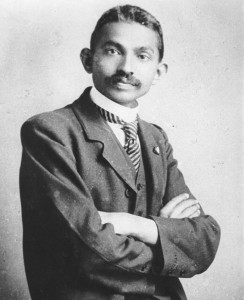 Mohandas and Kasturba had four more children, all sons: Harilal, born in 1888; Manilal, born in 1892; Ramdas, born in 1897; and Devdas, born in 1900. At his middle school in Porbandar and high school in Rajkot, Gandhi remained a mediocre student. He shone neither in the classroom nor on the playing field. One of the terminal reports rated him as “good at English, fair in Arithmetic and weak in Geography; conduct very good, bad handwriting.” He passed the matriculation exam at Samaldas College in Bhavnagar, Gujarat, with some difficulty. Gandhi’s family wanted him to be a barrister, as it would increase the prospects of succeeding to his father’s post.
Mohandas and Kasturba had four more children, all sons: Harilal, born in 1888; Manilal, born in 1892; Ramdas, born in 1897; and Devdas, born in 1900. At his middle school in Porbandar and high school in Rajkot, Gandhi remained a mediocre student. He shone neither in the classroom nor on the playing field. One of the terminal reports rated him as “good at English, fair in Arithmetic and weak in Geography; conduct very good, bad handwriting.” He passed the matriculation exam at Samaldas College in Bhavnagar, Gujarat, with some difficulty. Gandhi’s family wanted him to be a barrister, as it would increase the prospects of succeeding to his father’s post.
English Barrister
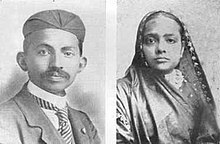
Gandhi and his wife Kasturba (1902)
In 1888, Gandhi travelled to London, England, to study law at University College London, where he studied Indian law and jurisprudence and trained as a barrister at the Inner Temple. His time in London was influenced by a vow he had made to his mother upon leaving India, in the presence of a Jain monk, to observe the precepts of abstinence from meat and alcohol as well as of promiscuity. Gandhi tried to adopt “English” customs, including taking dancing lessons. However, he could not appreciate the bland vegetarian food offered by his landlady and was frequently hungry until he found one of London’s few vegetarian restaurants. Influenced by Henry Salt’s writing, he joined the Vegetarian Society, was elected to its executive committee, and started a local Bayswater chapter. Some of the vegetarians he met were members of the Theosophical Society, which had been founded in 1875 to further universal brotherhood, and which was devoted to the study of Buddhist and Hinduliterature. They encouraged Gandhi to join them in reading the Bhagavad Gita both in translation as well as in the original. Not having shown interest in religion before, he became interested in religious thought.
Gandhi was called to the bar in June 1891 and then left London for India, where he learned that his mother had died while he was in London and that his family had kept the news from him. His attempts at establishing a law practice in Bombay failed because he was too shy to speak up in court. He returned to Rajkot to make a modest living drafting petitions for litigants, but he was forced to close it when he ran foul of a British officer. In 1893, he accepted a year-long contract from Dada Abdulla & Co., an Indian firm, to a post in the Colony of Natal, South Africa, then part of the British Empire.
Civil rights movement in South Africa (1893–1914)
Gandhi was 24 when he arrived in South Africa to work as a legal representative for the Muslim Indian Traders based in the city of Pretoria. He spent 21 years in South Africa, where he developed his political views, ethics and political leadership skills. Guha argues that when he returned to India in 1914 he was proficient at public speaking, fund-raising, negotiations, media relations, and self-promotion.
Indians in South Africa were led by wealthy Muslims, who employed Gandhi as a lawyer, and by impoverished Hindu indentured labourers with very limited rights. Gandhi considered them all to be Indians, taking a lifetime view that “Indianness” transcended religion and caste. He believed he could bridge historic differences, especially regarding religion, and he took that belief back to India where he tried to implement it. The South African experience exposed handicaps to Gandhi that he had not known about. He realised he was out of contact with the enormous complexities of religious and cultural life in India, and believed he understood India by getting to know and leading Indians in South Africa.
In South Africa, Gandhi faced the discrimination directed at all coloured people. He was thrown off a train at Pietermaritzburg after refusing to move from the first-class. He protested and was allowed on first class the next day. Travelling farther on by stagecoach, he was beaten by a driver for refusing to move to make room for a European passenger. He suffered other hardships on the journey as well, including being barred from several hotels. In another incident, the magistrate of a Durban court ordered Gandhi to remove his turban, which he refused to do.
These events were a turning point in Gandhi’s life and shaped his social activism and awakened him to social injustice. After witnessing racism, prejudice and injustice against Indians in South Africa, Gandhi began to question his place in society and his people’s standing in the British Empire.
Gandhi extended his original period of stay in South Africa to assist Indians in opposing a bill to deny them the right to vote. In regard to this bill Gandhi sent out a memorial to Joseph Chamberlain, British Colonial Secretary, asking him to reconsider his position on this bill. Though unable to halt the bill’s passage, his campaign was successful in drawing attention to the grievances of Indians in South Africa. He helped found the Natal Indian Congress in 1894, and through this organisation, he moulded the Indian community of South Africa into a unified political force. In January 1897, when Gandhi landed in Durban, a mob of white settlers attacked him and he escaped only through the efforts of the wife of the police superintendent. However, he refused to press charges against any member of the mob, stating it was one of his principles not to seek redress for a personal wrong in a court of law.
In 1906, the Transvaal government promulgated a new Act compelling registration of the colony’s Indian population. At a mass protest meeting held in Johannesburg on 11 September that year, Gandhi adopted his still evolving methodology of Satyagraha (devotion to the truth), or nonviolent protest, for the first time. He urged Indians to defy the new law and to suffer the punishments for doing so. The community adopted this plan, and during the ensuing seven-year struggle, thousands of Indians were jailed, flogged, or shot for striking, refusing to register, for burning their registration cards or engaging in other forms of nonviolent resistance. The government successfully repressed the Indian protesters, but the public outcry over the harsh treatment of peaceful Indian protesters by the South African government forced South African leader Jan Christiaan Smuts, himself a philosopher, to negotiate a compromise with Gandhi. Gandhi’s ideas took shape, and the concept of Satyagraha matured during this struggle.
Gandhi and the Africans
Gandhi focused his attention on Indians while in South Africa and opposed the idea that Indians should be treated at the same level as native Africans while in South Africa. He also stated that he believed “that the white race of South Africa should be the predominating race.” After several treatments he received from Whites in South Africa, Gandhi began to change his thinking and apparently increased his interest in politics. White rule enforced strict segregation among all races and generated conflict between these communities. Bhana and Vahed argue that Gandhi, at first, shared racial notions prevalent of the times and that his experiences in jail sensitized him to the plight of South Africa’s indigenous peoples.
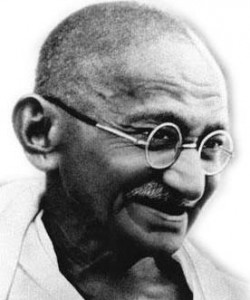 During the Boer war Gandhi volunteered in 1900 to form a group of ambulance drivers. He wanted to disprove the British idea that Hindus were not fit for “manly” activities involving danger and exertion. Gandhi raised eleven hundred Indian volunteers. They were trained and medically certified to serve on the front lines. At Spion Kop Gandhi and his bearers had to carry wounded soldiers for miles to a field hospital because the terrain was too rough for the ambulances. Gandhi was pleased when someone said that European ambulance corpsmen could not make the trip under the heat without food or water. General Redvers Buller mentioned the courage of the Indians in his dispatch. Gandhi and thirty-seven other Indians received the War Medal.
During the Boer war Gandhi volunteered in 1900 to form a group of ambulance drivers. He wanted to disprove the British idea that Hindus were not fit for “manly” activities involving danger and exertion. Gandhi raised eleven hundred Indian volunteers. They were trained and medically certified to serve on the front lines. At Spion Kop Gandhi and his bearers had to carry wounded soldiers for miles to a field hospital because the terrain was too rough for the ambulances. Gandhi was pleased when someone said that European ambulance corpsmen could not make the trip under the heat without food or water. General Redvers Buller mentioned the courage of the Indians in his dispatch. Gandhi and thirty-seven other Indians received the War Medal.
In 1906, when the British declared war against the Zulu Kingdom in Natal, Gandhi encouraged the British to recruit Indians. He argued that Indians should support the war efforts to legitimise their claims to full citizenship. The British accepted Gandhi’s offer to let a detachment of 20 Indians volunteer as a stretcher-bearer corps to treat wounded British soldiers. This corps was commanded by Gandhi and operated for less than two months. The experience taught him it was hopeless to directly challenge the overwhelming military power of the British army—he decided it could only be resisted in nonviolent fashion by the pure of heart.
After the black majority came to power in South Africa, Gandhi was proclaimed a national hero with numerous monuments.
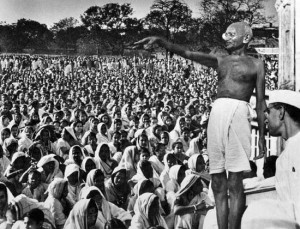 Indian Independence movement (1915-1947)
Indian Independence movement (1915-1947)
In 1915, Gandhi returned to India permanently. He brought an international reputation as a leading Indian nationalist, theorist and organiser. He joined the Indian National Congress and was introduced to Indian issues, politics and the Indian people primarily by Gopal Krishna Gokhale. Gokhale was a key leader of the Congress Party best known for his restraint and moderation, and his insistence on working inside the system. Gandhi took Gokhale’s liberal approach based on British Whiggish traditions and transformed it to make it look wholly Indian.
Gandhi took leadership of Congress in 1920 and began a steady escalation of demands (with intermittent compromises or pauses) until on 26 January 1930 the Indian National Congress declared the independence of India. The British did not recognise that and more negotiations ensued, with Congress taking a role in provincial government in the late 1930s. Gandhi and Congress withdrew their support of the Raj when the Viceroy declared war on Germany in September 1939 without consulting anyone. Tensions escalated until Gandhi demanded immediate independence in 1942 and the British responded by imprisoning him and tens of thousands of Congress leaders for the duration. Meanwhile the Muslim League did cooperate with Britain and moved, against Gandhi’s strong opposition, to demands for a totally separate Muslim state of Pakistan. In August 1947 the British partitioned the land, with India and Pakistan each achieving independence on terms that Gandhi disapproved.
The role of India in World War I
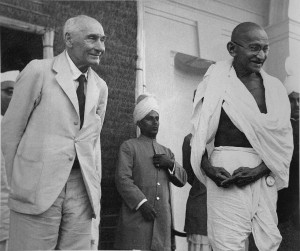 In April 1918, during the latter part of World War I, the Viceroy invited Gandhi to a War Conference in Delhi. Perhaps to show his support for the Empire and help his case for India’s independence, Gandhi agreed to actively recruit Indians for the war effort. In contrast to the Zulu War of 1906 and the outbreak of World War I in 1914, when he recruited volunteers for the Ambulance Corps, this time Gandhi attempted to recruit combatants. In a June 1918 leaflet entitled “Appeal for Enlistment”, Gandhi wrote “To bring about such a state of things we should have the ability to defend ourselves, that is, the ability to bear arms and to use them…If we want to learn the use of arms with the greatest possible despatch, it is our duty to enlist ourselves in the army.” He did, however, stipulate in a letter to the Viceroy’s private secretary that he “personally will not kill or injure anybody, friend or foe.”
In April 1918, during the latter part of World War I, the Viceroy invited Gandhi to a War Conference in Delhi. Perhaps to show his support for the Empire and help his case for India’s independence, Gandhi agreed to actively recruit Indians for the war effort. In contrast to the Zulu War of 1906 and the outbreak of World War I in 1914, when he recruited volunteers for the Ambulance Corps, this time Gandhi attempted to recruit combatants. In a June 1918 leaflet entitled “Appeal for Enlistment”, Gandhi wrote “To bring about such a state of things we should have the ability to defend ourselves, that is, the ability to bear arms and to use them…If we want to learn the use of arms with the greatest possible despatch, it is our duty to enlist ourselves in the army.” He did, however, stipulate in a letter to the Viceroy’s private secretary that he “personally will not kill or injure anybody, friend or foe.”
Gandhi’s war recruitment campaign brought into question his consistency on nonviolence. Gandhi’s private secretary noted that “The question of the consistency between his creed of ‘Ahimsa’ (nonviolence) and his recruiting campaign was raised not only then but has been discussed ever since.”



